|
|
Recent Progress on Additive Manufacturing of Piezoelectric Ceramics
NAN Bo, ZANG Jiadong, LU Wenlong, YANG Tingwang, ZHANG Shengwei, ZHANG Haibo
2022 Vol. 37 (6): 585–595
 Abstract
Abstract(
974 )
 HTML
HTML(
95)
 PDF
PDF(3110KB)(
1195
)
Piezoelectric ceramic is a type of functional ceramic, which is able to convert the mechanical signal and the electronic signal mutually. Composed of piezoelectric ceramics and organic phase, piezoelectric composites have different kinds of connectivities, which not only determine the diverse applications of piezoelectric devices, but also promote the development of various shaping techniques in manufacturing piezoelectric materials and devices. In comparison with the traditional shaping methods, the most distinguishable advantage of additive manufacturing lies in its ability of quickly shaping a small batch of samples into geometrically complex designs without a mould, which makes it a highly suitable technique for investigating piezoelectric ceramics and its derivative devices in different kinds of connectivities. Meanwhile, the final additively manufactured samples require only tiny post-processing, have a high rate of utilization of the raw material and do not need cutting fluid during manufacturing. Due to the above-mentioned advantages, it attracts the widespread concerns from both academic and industrial communities. When focusing in the field of additive manufacturing ceramics, the data of scientific reports in additive manufacturing functional ceramics and devices prove that it is still in a growing period. In the perspective of different additive manufacturing techniques, this article discusses and compares additive manufacturing of both lead-free and lead-based piezoelectric ceramics in the aspects of their historical development of each technique, preparation of the raw materials, geometrical designs, measurement of functional properties, and applications of the printed samples, and forecasts the future development based on the current benefits and drawbacks of each additive manufacturing technique.
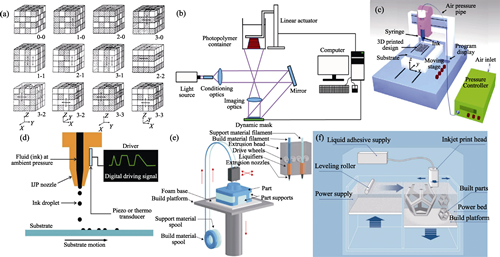
|
|
|
Columnar Nanograined BaTiO3 Ferroelectric Thin Films Integrated on Si with a Sizable Dielectric Tunability
ZHAO Yuyao, OUYANG Jun
2022 Vol. 37 (6): 596–602
 Abstract
Abstract(
525 )
 HTML
HTML(
33)
 PDF
PDF(1387KB)(
792
)
BaTiO3 has a wide range of applications in microelectromechanical systems and integrated circuits due to its excellent dielectric, ferroelectric, piezoelectric, and pyroelectric properties. For the applied research and device applications of BaTiO3 films, reducing its deposition temperature to be compatible with the CMOS-Si technology is an important Challenge. Here, with the help of a LaNiO3 buffer layer which has a closely-matched lattice with BaTiO3, (001)-textured BaTiO3 films were sputter-deposited at 450 ℃ on single crystalline Si(100) substrates, which consisting of well-cryotallized, evenly-distributed columnar nanograins with an average grain size of 27 nm. Our result showed that this deposition temperature can maintain the columnar nanograin structure with a relatively large grain size, leading to a good ferroelectric performance. In addition, a small residual strain on Si was also helpful to improve its ferroelectric and dielectric properties. The remnant polarization and saturated polarization of these BaTiO3 films reached 7 and 43 μC·cm-2, respectively, while leakage current densities were as low as 10-5 A·cm-2 at an applied electric field of 0.8 MV·cm-1. These BaTiO3 films also displayed excellent frequency stability with a low dielectric loss in which relative dielectric constant measured to be ~155 at 1 kHz, slightly being reduced to ~145 after increasing the frequency to 1 MHz. Meanwhile, the dielectric loss slightly increased from 0.01 at 1 kHz to 0.03 at 1 MHz. Lastly, through capacitance-voltage (C-V) tests, these films exhibited a large dielectric tunability of~51% and a figure of merit (FOM) of ~17 (@1 MHz). These films have a good potential for applications in tunable dielectrics.
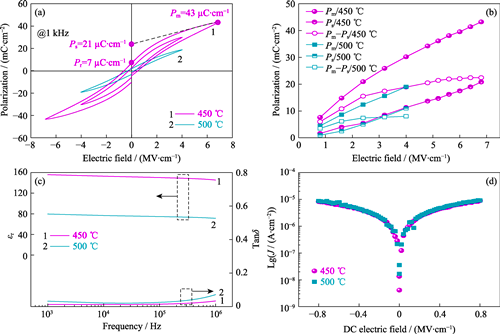
|
|
|
Field-induced Strain Property of Lead-free Ferroelectric Ceramics Based on Sodium Bismuth Titanate
YANG Huiping, ZHOU Xuefan, FANG Haojie, ZHANG Xiaoyun, LUO Hang, ZHANG Dou
2022 Vol. 37 (6): 603–610
 Abstract
Abstract(
474 )
 HTML
HTML(
33)
 PDF
PDF(3317KB)(
837
)
Piezoelectric actuators have advantages of fast response, high positioning accuracy, small size, and have received widespread attention in the field of precision drives. Lead-based piezoelectric actuators occupy the main commercial market. To avoid the use of the harmful element lead, a lead-free piezoelectric materials and actuators must be developed. Among them, bismuth sodium titanate (Bi0.5Na0.5)TiO3 (BNT), was reported but it has some disadvantages of higher driving voltage, larger hysteresis, and poor temperature stability. To optimize the strain performance of the lead-free actuator, this study adopted the solid-phase reaction method to prepare (1-x) {0.76(Bi0.5Na0.5)TiO3- 0.24SrTiO3}-xNaNbO3 (BNT-ST-xNN, x=0-0.03) lead-free ferroelectric ceramics, systematically studied its field- induced strain performance. The results show that when x=0.01, the strain value of the ceramic can reach 0.278% under a low electric field (E = 4 kV/mm), and the piezoelectric coefficient d*33 is as high as 695 pm/V. Meanwhile, the ceramic is at the non-ergodic/ergodic relaxation phase boundary, and the electric field induced relaxor-ferroelectric phase transition leads to large field-induced strain. Compared with x=0.01, the strain value at x=0.02 is 0.249%, which is slightly reduced, but the hysteresis is significantly reduced to 43% of the comparator. In addition, the strain remains stable in the temperature range of 25-100 ℃. This study shows that introduction of SrTiO3 and NaNbO3 into BNT can increase the field-induced strain value while maintaining a low driving voltage and good temperature stability, indicating suitable for the development of piezoelectric actuators.
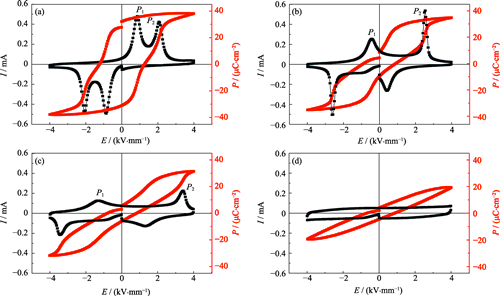
|
|
|
Electrochromic Property of Perovskite Ceramic Films
HUANG Zhihang, TENG Guanhongwei, TIE Peng, FAN Desong
2022 Vol. 37 (6): 611–616
 Abstract
Abstract(
479 )
 HTML
HTML(
23)
 PDF
PDF(1129KB)(
606
)
Perovskite manganese oxide (PMO) has attracted extensive attention in the field of heat dissipation because of its discoloration stimulated by external conditions. At present, most of the researchs on the discoloration characteristics of PMO is based on temperature excitation, and there still lacks of heat dissipation equipment excited by electric field. In addition, because the electric field excitation is accompanied by Joule heat, electrochromic property of PMO materials has not been clearly proved. In view of the above challenges, here an electrical modification method for PMO materials is proposed by using influence of electric field excitation on Mn elements in PMO. Thermochromic property of PMO was greatly weakened by electrical modification, and then La0.7Ca0.25K0.05MnO3 (LCKMO) can eliminate the influence of Joule heat in electric field excitation experiment. We studied the thermochromic and electrochromic properties of LCKMO before and after electrical modification. Emittance of LCKMO before electrical modification increases with the increase of temperature with the maximum increment at 17%. After being excited by 21 V electric field, the emittance increases by 15%, 16%, 10%, 0.6% and 1.4% at 173, 203, 243, 273, and 373 K, respectively. The thermochromic property of electrically modified LCKMO is greatly weakened, and its emittance increases by 10.7% and 9.3% at 273 and 373 K, respectively, after being excited by 21 V electric field. The experimental results before and after electrical modification show that LCKMO has electrochromic property, and there is an obvious regulation mechanism of electric field excitation on the emissivity. Therefore the electrical modification method for PMO materials can not only enable the electrochromic study of PMO materials without the influence of Joule heat, but also provides a new possibility for regulation of the thermochromic property of PMO materials.
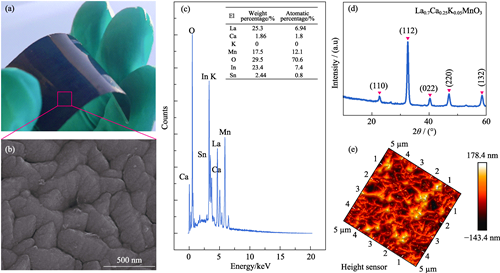
|
|
|
Preparation and Properties of Barium Titanate/Calcium Silicate Composite Bioactive Piezoelectric Ceramics
WEI Ziqin, XIA Xiang, LI Qin, LI Guorong, CHANG Jiang
2022 Vol. 37 (6): 617–622
 Abstract
Abstract(
508 )
 HTML
HTML(
28)
 PDF
PDF(12299KB)(
986
)
Electrical signals generated by piezoelectric materials can promote proliferation and differentiation of osteoblasts, but they can’t induce mineralization, while bioactive materials can induce the deposition of bone like hydroxyapatite in physiological environment, but can not generate electrical signal to promote osteogenesis. Therefore, it is of great significance to develop a composite bioactive piezoelectric material that can not only generate electrical signals, but also induce mineralization and deposition. Here, we used barium titanate as piezoelectric component and calcium silicate as bioactive component to prepare barium titanate/calcium silicate composite as bioactive/piezoelectric ceramics by solid-state sintering method. Piezoelectric properties of the ceramics were tested, and the ability of inducing mineralization was evaluated by in vitro mineralization experiment. The experimental results show that when the content of calcium silicate reaches 30%, the composite ceramics still have certain piezoelectric property (d33=4 pC·N-1), and can induce the deposition of calcium phosphate in simulated body fluid. Therefore, the combination of barium titanate and calcium silicate can synchronously afford piezoelectric and biological activities, which provides a new choice for bone repair materials.
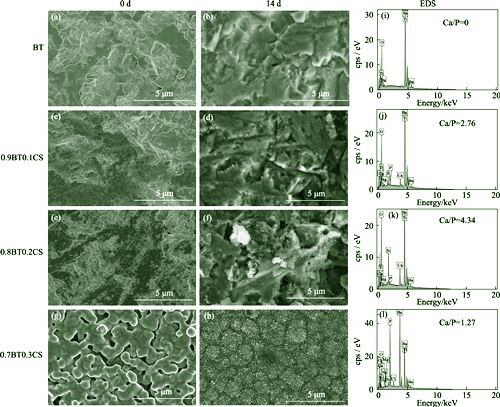
|
|
|
Binderless Layered BN Toughened cBN for Ultra-precision Cutting
CHEN Junyun, SUN Lei, JIN Tianye, LUO Kun, ZHAO Zhisheng, TIAN Yongjun
2022 Vol. 37 (6): 623–628
 Abstract
Abstract(
526 )
 HTML
HTML(
17)
 PDF
PDF(1675KB)(
760
)
Poor toughness and high synthesis pressure of binderless cBN limits its application in the field of cutting tool. To enhance its toughness, an advanced layered BN toughened cBN (Lt-cBN) bulk was developed under industrial pressure. Then, the cutting performance and wear resistance of Lt-cBN was analyzed based on the unique microstructure during tungsten carbide cutting. It is found that the Lt-cBN reaches a high fracture toughness of 8.5 MPa·m1/2, and is capable of realizing ultra-precision cutting of tungsten carbide with smooth surface of roughness lower than Ra 10 nm. The layered BN at the intersection of cBN grains within Lt-cBN contributes to the enhanced toughness, which further slows down the transformation of amorphization as well as the wear rate of the surface layer. Thus Lt-cBN exhibits better cutting performance and wear resistance in contrast to commercial binderless pure cBN material. The wear of Lt-cBN can be explained by the soft partially amorphous layer formed on the flank surface being rubbed and continuously removed in the form of abrasive wear.
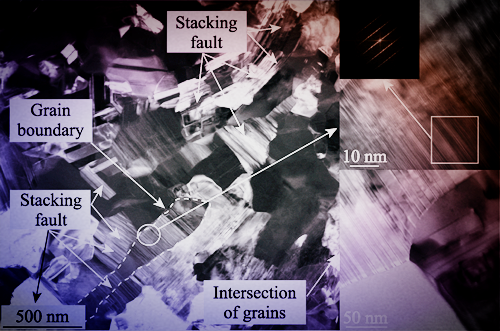
|
|
|
High Temperature Tensile Property of Domestic 550-grade Continuous Alumina Ceramic Fiber
WANG Xingang, YANG Qingqing, LIN Genlian, GAO Wei, QIN Fulin, LI Rongzhen, KANG Zhuang, WANG Xiaofei, JIANG Danyu, YAN Jina
2022 Vol. 37 (6): 629–635
 Abstract
Abstract(
486 )
 HTML
HTML(
34)
 PDF
PDF(1326KB)(
1094
)
Oxide fiber has good thermostability and oxidation resistance at high temperature, is one of the important candidates for the reinforcements of composites for aerospace field. The tensile property at high temperature is one of the critical properties of oxide fiber used in harsh environment, but the related research about domestic 550-grade fiber is rarely reported. Here the tensile property of domestic 550-grade continuous alumina fiber at high temperature and its room temperature tensile property after heat treatment were studied. Relationships between the tensile strength and the phase transition, the microstructures, as well as their internal mechanism were investegated. The results showed that the fiber multifilament and filaments had relatively high tensile strength with strength retention rate up to 1100 ℃. The poor thermostability of amorphous SiO2 had obviously adverse effect on the tensile property of the fiber at temperature above 1200 ℃. Importantly, at the critical phase transition temperature (1300 ℃) mullite plase was formed, which could improve the fiber tensile strength at 1250-1400 ℃. This work demonstrated that the tensile strength of SIC550 fiber at 1100 ℃ was close to that of Nextel 720 and CeraFib by considering the effect of different gauge length.
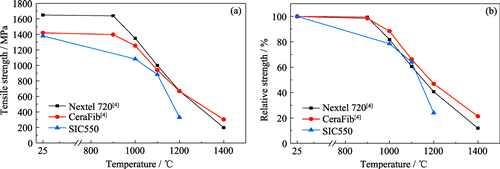
|
|
|
Effect of Boron Carbide Particle Size Distribution on the Microstructure and Properties of Reaction Bonded Boron Carbide Ceramic Composites by Silicon Infiltration
XIA Qian, SUN Shihao, ZHAO Yiliang, ZHANG Cuiping, RU Hongqiang, WANG Wei, YUE Xinyan
2022 Vol. 37 (6): 636–642
 Abstract
Abstract(
420 )
 HTML
HTML(
14)
 PDF
PDF(3443KB)(
743
)
Effect of particle size of boron carbide raw material on the phase composition, microstructure and properties of reaction bonded boron carbide composites was investigated. It was found that particle gradation can make the powder packing more compact and effectively improve the volume density of green body, decreasing the content of free Si in the composites. Addition of coarse particles can reduce the reaction between B4C and Si, which can generate SiC phase. When the weight ratio of B4C powders with different particle sizes (3.5, 14, 28, 45 μm) is 1.5 : 4 : 1.5 : 3, the Vickers hardness, flexure strength, fracture toughness and volume density of the composites are (29±5) GPa, (320±32) MPa, (3.9±0.2) MPa·m1/2 and 2.51g/cm3, respectively. The retard of reaction between B4C and Si, and the decrease of free Si content along with the shrinkage of size of Si zone in the composites, are the main reasons for the improvement of the composite mechanical properties.
|
|
|
Tribological Properties of Plasma Sprayed TiC-Graphite Composite Coatings
HONG Du, NIU Yaran, LI Hong, ZHONG Xin, ZHENG Xuebin
2022 Vol. 37 (6): 643–650
 Abstract
Abstract(
402 )
 HTML
HTML(
9)
 PDF
PDF(7637KB)(
773
)
Plasma sprayed TiC coating has now been a frequent choice for wear-resistant applications in extreme environments owing to its good comprehensive performance. Meanwhile, graphite is an excellent self-lubricating material. Here, spherical TiC-Graphite composite powders with different contents of graphite (1.25%, 2.5%, 5%, and 10% in mass) were fabricated by spray drying and vacuum sintering, and then TiC-Graphite composite coatings were prepared by atmospheric plasma spray (APS) technology. The phase composition, microstructure and mechanical properties of the coatings were characterized, and its tribological performances were evaluated. The results showed that the TiC-Graphite coatings were mainly composed of TiC and graphite phases. With the increase of graphite addition, the micro-cracks in the section and the roughness of the TiC-Graphite coatings increased while the hardness gradually decreased. Compared with low load, graphite had more significant effect on wear performance of the TiC coating under high load. Under the load of 50 N, wear rate of the TiC-Graphite coating first decreased and then increased, but the friction coefficient kept decreasing with the increase of graphite addition. When the graphite addition was 0.25%, the minimum wear rate of 0.67×10-5 mm3/(N·m) was obtained, whereas the friction coefficient was 0.35, which were reduced by 72.4% and 27.8% compared with the pure TiC coating, respectively.
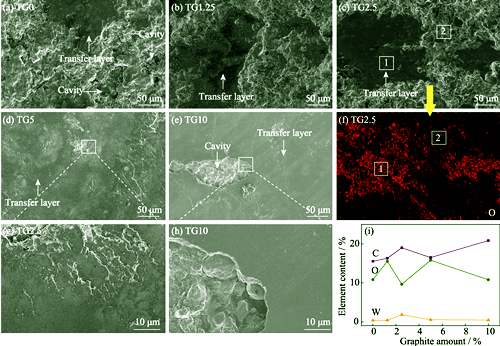
|
|
|
First-principles Study on Interface of Reduced Graphene Oxide Reinforced Aluminum Matrix Composites
SUN Ming, SHAO Puzhen, SUN Kai, HUANG Jianhua, ZHANG Qiang, XIU Ziyang, XIAO Haiying, WU Gaohui
2022 Vol. 37 (6): 651–659
 Abstract
Abstract(
382 )
 HTML
HTML(
22)
 PDF
PDF(3827KB)(
766
)
An “aluminum/graphene oxide/aluminum (Al/GO/Al)” interface model with different carbon/oxygen ratio or with different defects was established. Effects of oxygen-containing functional groups and different defects on the interface of reduced graphene oxide/aluminum composites was studied using first principle method based on density functional theory (DFT). The results show that the epoxy group is better than carbon atom to produce obvious charge interaction with aluminum atom in the interface model of Al/GO/Al. The net charge of oxygen atom is -0.98 e while aluminum atom is 0.46 e, which is conducive to the interfacial bonding between reduced graphene oxide (RGO) and aluminum matrix in composites. When the defects exists, the net charge of carbon atoms at the defects in the Al/GO/Al interface model is in the range of -0.05 e to -0.38 e. Interaction between epoxy group and carbon atoms is weak, while interaction between epoxy group and aluminum atoms is significantly intensified. The existence of epoxy group can inhibit reaction between carbon atom and aluminum atom in the vacancy defects, and protect integrity of carbon structure in RGO with vacancy defects. Therefore, this research may provide theoretical guidance for development of high-performance Al/GO/Al matrix composites.
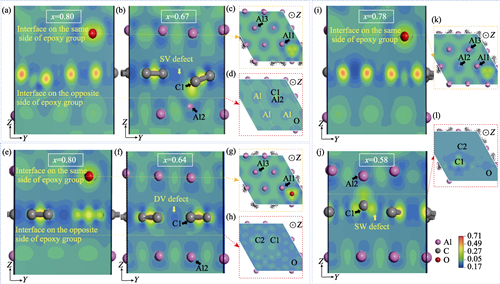
|
|
|
Halogenated Ti3C2 MXene as High Capacity Electrode Material for Li-ion Batteries
XIAO Meixia, LI Miaomiao, SONG Erhong, SONG Haiyang, LI Zhao, BI Jiaying
2022 Vol. 37 (6): 660–668
 Abstract
Abstract(
644 )
 HTML
HTML(
23)
 PDF
PDF(4178KB)(
883
)
MXenes have been widely studied for their excellent specific surface area, high conductivity and composition tunability, which have been used as a highly efficient electrode material for lithium-ion batteries (LIBs). However, limited storage capacity and severe lattice expansion caused by Li-ions diffusion restrict the application of MXenes as electrode materials. Here, Ti3C2 MXenes with surface halogenation (fluorination, chlorination and bromination) as representative MXene materials were designed. Effects of surface functionalization on the atomic structures, electronic properties, mechanical properties, and electrochemical performance of Ti3C2T2 (T = F, Cl and Br) anode in LIBs were investigated using first-principles calculations based on density functional theory with van der Waals correction. The results reveal that Ti3C2T2 MXenes exhibit metallic conductivity with improved structural stability and mechanical strength. Compared with Ti3C2F2 and Ti3C2Br2, Ti3C2Cl2 exhibits the large elastic modulus (321.70 and 329.43 N/m along x and y directions, respectively), low diffusion barrier (0.275 eV), high open circuit voltage (0.54 eV), and storage capacity (674.21 mA·h/g) with stoichiometric ratio of Ti3C2Cl2Li6, which renders the enhanced rate performance and endures the repeated lattice expansion and contraction during the charge/ discharge process. Moreover, surface chlorination yields expanded interlayer spacing, which can improve Li-ion accessibility and fast charge-discharge rate in Ti3C2Cl2. The research demonstrates that Cl- terminated Ti3C2 is a promising anode material, and provides effective and reversible routes to engineering other MXenes as anode materials for LIBs.
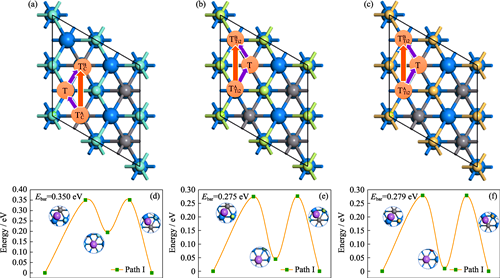
|
|
|
Performance of Perovskite solar cells Doped with L-arginine
JIAO Boxin, LIU Xingchong, QUAN Ziwei, PENG Yongshan, ZHOU Ruonan, LI Haimin
2022 Vol. 37 (6): 669–675
 Abstract
Abstract(
570 )
 HTML
HTML(
36)
 PDF
PDF(2873KB)(
861
)
Perovskite solar cells have become a research hotspot in the field of new energy due to the excellent performance and potential in application, but it still displays some disadvantages such as high defect density and poor stability. In this study, L-arginine, a small molecule of organic matter, was doped into the perovskite precursor soLution as compared with the other amino acids, and the perovskite solar cells were prepared by a two-element and two-step preparation method. The test results show that L-arginine doping improves the photoelectric performance of the device, which photoelectric efficiency increases from 18.81% to 21.86%. L-arginine reduces the nonradiative recombination of carriers and increases the average carrier life by reducing the defect density of perovskite layer from 4.83×1016 cm-3 to 3.45×1016 cm-3. In addition, the perovskite grain size increases, grain boundaries decrease, the light absorption ability and stability of the film are enhanced, while the hysteresis effect is suppressed. Improvement of the photovoltaic performance is due to the passivation of defects by interaction between multi-groups of L-arginine and perovskite materials. This study provides an optimization method for perovskite solar cells.
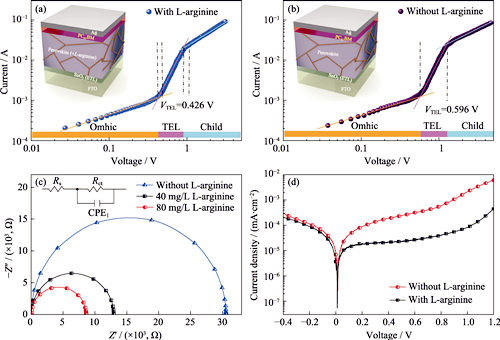
|
|
|
Microstructure and Thermal Quenching Characteristics of Na1-xMxCaEu(WO4)3 (M=Li, K) Red Phosphor
GUAN Xufeng, LI Guifang, WEI Yunge
2022 Vol. 37 (6): 676–682
 Abstract
Abstract(
274 )
 HTML
HTML(
13)
 PDF
PDF(2782KB)(
605
)
Red phosphors play a vital role in improving the photoluminescence properties of white LEDs (w-LEDs). In order to prepare high efficiency and stability red phosphor for commercial LED chips, a series of tetragonal scheelite structure Na1-xMxCaEu(WO4)3 (M=Li, K) red phosphors were synthesized by a solid state reaction method. The effect of Li+ and K+ doping on the crystal structure, photoluminescence properties and thermal quenching characteristics of NaCaEu(WO4)3 phosphor were investigated systematically. Rietveld refinement results show that the doping of Li+ and K+ exerts change on the tetragonal scheelite structure of the NaCaEu(WO4)3 host, but forms the solid solution, and results in the regular change in the lattice constant. The photoluminescence spectra show that under the excitation of near ultraviolet light at 395 nm, the phosphors exhibit a typical red emission, with the strongest emission peak at 617 nm, corresponding to the 5D0→7F2 transition of Eu3+ ion, which indicates that Eu3+ is situated in non-central symmetric lattices in NaCaEu(WO4)3 host. It is noteworthy that the doping of Li+ and K+ effectively improves the emission intensity of the NaCaEu(WO4)3 phosphor. When the doping concentration (molar percent) of Li+ and K+ is 100% and 30%, respectively, both the emission intensity and the color purity realize optimum. In addition, thermal stability and thermal quenching characteristics of Na1-xMxCaEu(WO4)3 (M=Li, K) phosphors were studied. The results show that both Li+ and K+ doped phosphors display excellent thermal quenching, and when the Li+ doping concentration (molar percent) is 100%, LiCaEu(WO4)3 phosphor processes the best thermal quenching. All results demonstrate that Na1-xMxCaEu(WO4)3 (M= Li, K) red phosphors can be applied to high-power NUV (Near ultraviolet) excited white light emitting diodes potentially.
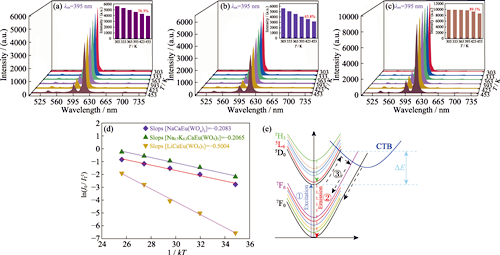
|
|
|
Microstructure and Mechanical Properties of SiC Joint Brazed by Al-Ti Alloys as Filler Metal
XU Puhao, ZHANG Xiangzhao, LIU Guiwu, ZHANG Mingfen, GUI Xinyi, QIAO Guanjun
2022 Vol. 37 (6): 683–690
 Abstract
Abstract(
385 )
 HTML
HTML(
20)
 PDF
PDF(9483KB)(
754
)
SiC ceramic has excellent overall properties, and joining it to other materials with high joint strength is an important issue in the actual applications. Brazing of SiC ceramic to itself was performed using the as-fabricated Al-(10, 20, 30, 40)Ti alloys with nominal Ti concentrations of 10%, 20%, 30%, and 40% at 1550 ℃ × 30 min. The average joint shear strength fluctuates in the range of ~100‒260 MPa with the interlayer thickness of ~50 μm. Moreover, the average strength SiC/Al-20Ti/SiC joint is increased markedly with the interlayer thickness decreasing from ~100 to 25 μm, reaching the maximum of ~315 MPa. Meanwhile, the (Al) phase in the interlayers is reduced gradually till disappear with the thinnest brazing interlayer, leaving the Al4C3, TiC and (Al,Si)3Ti phases in the interlayer. The joint fractures of SiC/Al-20Ti/SiC joint mainly occur in the SiC ceramic substrate near the interlayer/ceramic interface.
|
|
|
Stability of Low-index Surfaces of Cs2SnI6 Studied by First-principles Calculations
LIN Aming, SUN Yiyang
2022 Vol. 37 (6): 691–696
 Abstract
Abstract(
385 )
 HTML
HTML(
24)
 PDF
PDF(2109KB)(
699
)
Cs2SnI6 is a stable and environmentally friendly halide perovskite material with great potential for photovoltaic and optoelectronic applications. While the surface properties are of paramount importance for device fabrications, there have been no such theoretical studies on this material. Using density functional theory calculations with the SCAN+rVV10 functional, the (001), (011) and (111) surfaces of Cs2SnI6 were studied to reveal their thermodynamic stability. We constructed seven models for these surfaces, including two along the (001) orientation (CsI2- and SnI4-terminated surfaces), two along the (011) orientation (I4- and Cs2SnI2-terminated surfaces) and three along the (111) orientation (non-stoichiometric CsI3-, Sn- and stoichiometric CsI3-terminated surfaces). Because most of the surfaces are non-stoichiometric, their relative stability depends on the experimental preparation condition, which is reflected by the chemical potentials of the constituent elements in the calculation. By determining the allowed chemical potential region, the thermodynamic stability of these Cs2SnI6 surfaces is analyzed. The results show that the surface energies of the (001) and (011) surfaces are affected by the chemical potentials, while the stoichiometric CsI3-terminated (111) surface is unaffected by the chemical potentials and is energetically the most stable surface of Cs2SnI6. Thus, the observed exposure of (111) surface of Cs2SnI6 crystals in several recent experiments is determined to be driven by thermodynamics.
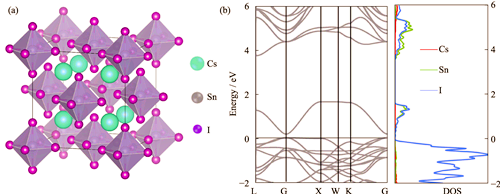
|
|